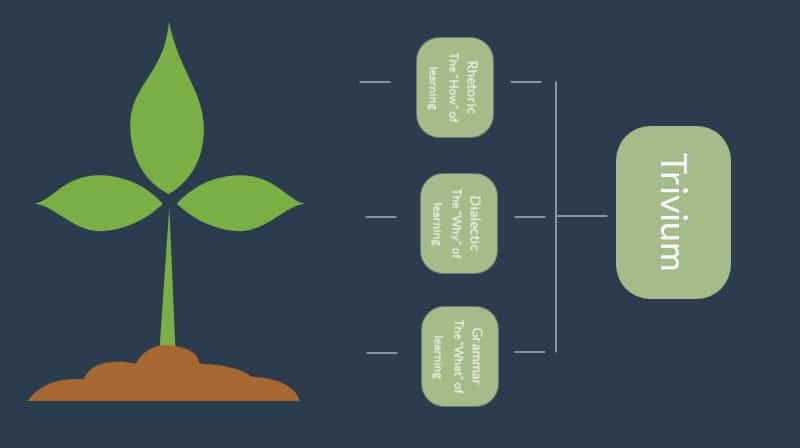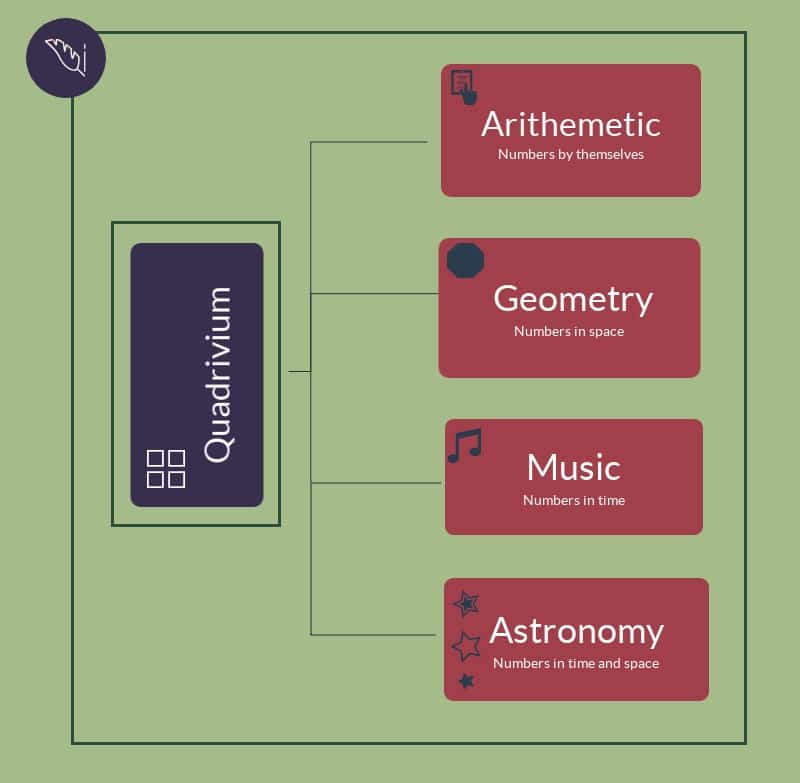As parents and teachers join the classical education movement, it can sometimes be hard to get up to speed on the terminology. Whether it’s from teachers, administrators or fellow parents, there’s a lot of big and fancy words being tossed around, like trivium and quadrivium. If that weren’t enough, confusingly, words we thought we knew, like the liberal arts, music, science and gymnastic are being used in different ways.
How is a newcomer to make sense of it all?
This article attempts to break down the important terminology of the classical tradition. Inevitably, this set of definitions is biased toward a particular account of what classical education is and means, but hopefully it serves as starting point for the interested parent or educator to get some of the basic assumptions of the conversation.
Let’s start with the big picture by looking at a definition of Classical Education itself. Then we’ll tackle the Seven Liberal Arts of the Classical Tradition, the Foundational Elements of the Classical Tradition, and finally Philosophy or the Three Sciences of the Classical Tradition.
1. Classical Education
Classical education is the disciplined pursuit of wisdom in community.
The goal of classical education isn’t simply acquiring information or skills, but a holistic wisdom for life, derived from the traditional sources of wisdom in philosophy, science, the arts, literature, math and history. The methods are, therefore, hard, requiring discipline from the student in body and mind. Learning is a communal process of engaging with the best that’s been written, thought or expressed. This requires a mastery of the seven liberal arts and the sciences.
2. The Seven Liberal Arts of the Classical Tradition
The seven liberal arts are more like well-worn pathways in the pursuit of wisdom, than our standard school subjects. They aim to train the student in intellectual virtue so that they discover reliable knowledge in the sciences. The liberal arts start with the Trivium, or or three-fold path of language arts, followed by the Quadrivium, or four mathematical arts.
The liberal arts start with the Trivium, or or three-fold path of language arts, followed by the Quadrivium, or four mathematical arts.
We should think of the term ‘art’ in the classical tradition, as indicating that these are complex skills to be trained in, rather than simply information to be memorized and regurgitated on a scantron test.
2.1 The Trivium

The Trivium includes Grammar, Logic or Dialectic, and Rhetoric. The first wave of the classical school movement focused on Dorothy Sayer’s identification of the Trivium as stages of learning corresponding to a basic facts and memorization stage (Grammar), the critical thinking and arguing stage (Logic), and the stage of blossoming creativity and poetics (Rhetoric). Sayers called these the poll-parrot, pert and poetic stages, and they roughly correspond to the traditional elementary, middle and high school paradigm of the U.S. education system.
The second wave of the classical school movement has focused more attention on the historical variations in the tradition of grammatical, dialectical and rhetorical training. Kevin Clark and Ravi Jain in their book The Liberal Arts Tradition contend that many aspects of the “grammar stage” actually better refer to what they call ‘musical education’ (see below).
2.1.1. Grammar originally referred to something much bigger than parts of speech and diagramming sentences; it encompassed the reading and interpretation of texts in general, with all the background knowledge and sub-skills that that entails.
2.1.2 Dialectic was the process of discerning the truth through discussion and debate. It is perhaps best exemplified by Socrates’ famous dialogues, though honed to a different sort of perfection in Thomas Aquinas’ famous scholastic method of question, answer, objection and synthesis in the Summa Theologica.
2.1.3 Rhetoric has a long and varied tradition rooted in the ancient political and legal wranglings of Greek and Roman orators, though it has been continuously reapplied in different cultural settings down to this day. From the conventions of spoken and written discourse to the skills of developing and articulating an argument, rhetoric is the art of making decisions in a community through leadership and communication.
It’s probably better to think of the Trivium arts as core competencies or language arts skills that admit of a basic mastery but also of continual improvement. Reading and interpretation, discussion and reasoning, spoken and written composition are the tools of learning in any subject. They are a method of effective learning, not just a curriculum. As students get better at them, they get better at the process of learning itself. (For more on this see an earlier series of blog articles on “The Liberal Arts of the Trivium.”)
2.2 The Quadrivium

The quadrivium were the mathematical arts of arithmetic, geometry, music and astronomy.
2.1. Arithmetic: dealt with the manipulation of numbers;
2.2. Geometry: numbers extended in space;
2.3. Music: numbers extended over time;
2.4. Astronomy: numbers extended in space and over time.
Algebra and calculus, as modern discoveries, can be seen as extending the investigations of the earliest mathematicians. They are natural outgrowths of the classical tradition of mathematics, rather than radical departures from it. This can be demonstrated from the fact that famous mathematicians were often interacting with ancient Greek mathematical philosophers.
For more information, check out Ravi Jain’s sections in The Liberal Arts Tradition or my earlier blog article on “Classical Education and STEM: A Common Misconception.”
3. Foundational Elements of the Classical Tradition
In addition to the seven traditional liberal arts, recent classical educators, like Kevin Clark and Ravi Jain, have emphasized other more holistic aspects of the classical tradition. The liberal arts aim primarily at cultivating intellectual virtue, they argue, but the ancients and medievals were interested in the body, heart, and soul as well. So these two authors have included piety, gymnastic and musical education in order to capture the classical tradition’s goal of cultivating the whole human person.
3.1 Piety
Piety is that heartfelt love for God and neighbor that inspires a sense of duty, responsibility and obligation to take care of others. In our day and age of radical individualism, piety asserts instead that we have a responsibility to use our gifts and resources in the service of God and neighbor.
This sense is instilled in the student not so much through a particular subject or curriculum (though chapel, discussing the Bible, and singing hymns can certainly help), but through a genuine and embodied culture of faith and service. It’s caught more than taught.
3.2 Gymnastic Education
The training of the gymnasium was central to the fitting out of citizens ready to serve their community in times of need and times of plenty. Bodily fitness, sports, and habits of prompt and active obedience, attention and engagement with the task at hand are absolutely essential even for the life of a scholar, let alone an active member of the community.
Unfortunately, the modern dichotomy between body and mind too often sequesters the jocks and nerds, as if it were not possible to excel in both arenas: the physical and the intellectual. In fact, modern research is confirming how much proper exercise supports learning, implying that body and mind work best in tandem, as the ancient gymnasium implied.
3.3 Musical Education
Not to be confused with the mathematical art of the Trivium, musical education refers to the inspirational literature, poetry, music, nature and art that are cherished and celebrated by young and old. The Muses of ancient Greek mythology inspired not only various types of music, poetry, and epics, but also history and astronomy.
Musical education recognizes that the curriculum choices will necessarily nurture cultural values and norms at a deep and heartfelt level. There is no such thing as a value-neutral education. It can inspire in us the love of things that are lovely, excellent, honorable and praiseworthy, or the opposite. Education simply can’t be reduced to information and skills.
4. Philosophy or the Three Sciences of the Classical Tradition
Last in the liberal arts tradition paradigm are the three sub-disciplines of philosophy:
4.1 Natural Science,
4.2 Ethical or Moral Science, and
4.3 Metaphysics.
Before the modern era the terms ‘philosophy’ and ‘science’ were virtually interchangeable. Philosophy, meaning “the love of wisdom,” represented the highest aim of classical education. The term ‘science’ comes from the Latin word for knowledge, and therefore pointed to all that could be known about the world.
Philosophy or the sciences map on to what we think of as subjects in the modern world: they are organized bodies of knowledge about a particular sphere of all that can be known. Every subject, therefore, can fit into the three spheres of Nature, Humanity (or moral science) and Being itself, or the overarching principles governing all things (metaphysics or divine science).
For Christians the fact of divine revelation provides a new source of knowledge in the Bible, making theology the Queen of the Sciences. Theology is the queen because the knowledge we gain from God’s self-revelation often causes a radical reorientation and reassessment of human knowledge and wisdom. All that could be known through merely human means must now be colored through the gospel glasses of a Christian worldview.
Those are my definitions of key terminology for the classical education movement. However, I’d like to recognize my dependence on Kevin Clark and Ravi Jain, who are both good friends from my year at the Geneva School in Orlando, FL. But they would no doubt summarize things differently, since I’ve definitely put my own spin on their research and interacted with their paradigm in several ways.
In the comments I’d love to hear of any other terms that you’ve heard that you would like explained. I’m sure there are things I’ve missed in this overview that could be added in or handled in another article.
{{cta(‘dc138f10-0915-430c-a448-47831c29a9f4′,’justifycenter’)}}
{{cta(‘13402357-7472-4e29-b7d3-e218cde05113′,’justifycenter’)}}




